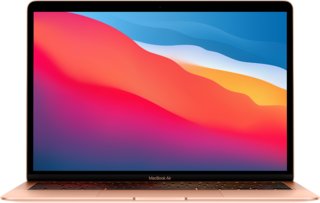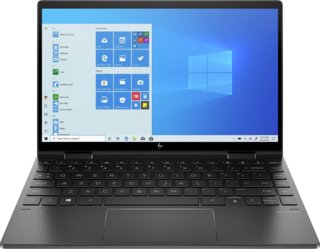Apple MacBook Air (2020) 13.3" Apple M1 vs HP Envy x360 13 (2020) AMD Ryzen 5 4500U
Welcome to our detailed analysis of two highly-discussed laptops of 2020 - the Apple MacBook Air and the HP Envy x360 13. Both models are recognized for their remarkable specifications and stylish design, each having unique strengths. This article serves to clarify which laptop might be the ideal fit for you, whether you're a creative professional, a student, or someone who appreciates efficiency and high performance. We’ll thoroughly examine their features, contrasting elements from their processing power to storage provisions, aimed at assisting your decision-making process. So unwind, get comfortable, and let's explore this tech fascination together!
System and application performance
Performance in popular 3D games
Viewing angle, color accuracy...
Ports, webcam and other interfaces
Potential battery life
Materials, durability and portability
Performance Comparison
| Apple MacBook Air (2020) 13.3" Apple M1 | HP Envy x360 13 (2020) AMD Ryzen 5 4500U | |
|---|---|---|
| Geekbench 5 Multi | 7361 | 4097 |
| Geekbench 5 Single | 1699 | 1082 |
| Passmark | 15127 | 11097 |
| Passmark Single | 3757 | 2454 |
Comparing the performance of the Apple MacBook Air (2020) and the HP Envy x360 13 (2020) involves analyzing benchmark scores to understand their capabilities in real-world tasks and applications. Let's explore how the hardware specifications of these laptops influence their performance in different scenarios.
Apple MacBook Air (2020)
- Apple M1 Chip
- Geekbench 5 Multi: 7361
- Geekbench 5 Single: 1699
- Passmark: 15127
- Passmark Single: 3757
Performance Highlights:
- The Apple M1 chip, a chip specifically designed by Apple, demonstrates outstanding single-core performance, evident in its high Geekbench single-core score of 1699.
- The MacBook Air provides strong multi-core processing power with a Passmark score of 15127, making it great for multitasking and running demanding applications. The efficiency of the M1 chip ensures smooth performance in tasks such as video editing, photo manipulation, and light gaming.
HP Envy x360 13 (2020)
- AMD Ryzen 5 4500U
- Geekbench 5 Multi: 4097
- Geekbench 5 Single: 1082
- Passmark: 11097
- Passmark Single: 2454
Performance Highlights:
- The AMD Ryzen 5 4500U processor on the HP Envy delivers a well-rounded performance with strong multi-core capabilities, evident in its Geekbench score of 4097.
- Although its single-core performance falls short of the M1 chip, the A14 chip remains reliable for everyday tasks and basic productivity needs.
- The HP Envy x360 is a reliable choice for business professionals requiring solid performance for office tasks, web browsing, and basic content creation.
Real-World Application Comparison:
Design Software Rendering:
- The MacBook Air's superior multi-core performance makes it ideal for rendering tasks in design software like Adobe Creative Suite, providing faster turnaround times on complex projects.
Gaming Frame Rates:
- Gamers might prefer the MacBook Air for its higher single-core performance when running less demanding titles or older games that rely heavily on single-threaded processes.
Business Application Processing Speeds:
- The HP Envy x360 provides professionals with reliable multitasking capabilities for business applications like Microsoft Office suite or accounting software.
In summary, the MacBook Air stands out for power-intensive applications and tasks thanks to its impressive M1 chip architecture, while the HP Envy x360 offers a well-rounded performance for daily computing needs and light productivity tasks.
Design Comparison
Size Comparison
Design Comparison: Apple MacBook Air (2020) vs. HP Envy x360 13 (2020)
When analyzing the design features of the Apple MacBook Air (2020) and the HP Envy x360 13 (2020), different aspects impact user experience, covering ergonomics and portability. Let's explore how these design traits accommodate diverse user requirements:
Ergonomics:
- MacBook Air: The MacBook Air's fanless design provides silent operation and enhanced comfort while in use.
- HP Envy x360: Both models feature a backlit keyboard, allowing users to work comfortably in low-light environments.
Materials & Build Quality:
- Both laptops are slim, measuring about 0.6 inches in thickness, for a sleek and modern look.
- The MacBook Air weighs a bit less at 2.8 pounds than the HP Envy x360, which weighs 2.9 pounds, making it more portable while maintaining durability.
Unique Design Features:
- MacBook Air: Features Thunderbolt 3 ports for flexible connectivity and a stylish design.
- HP Envy x360: Includes a touchscreen for seamless user interaction using various input methods.
Portability:
- With widths around 12 inches and heights under 8.5 inches, both laptops have compact dimensions that are perfect for on-the-go productivity.
Practical Usability & Aesthetic Appeal:
- Students: The lightweight build of the MacBook Air makes it convenient for students who need to carry their laptop between classes.
- Professionals: The touch screen functionality of the HP Envy x360 caters to professionals requiring versatility in their workflow.
Influence on User Experience:
- MacBook Air: The inclusion of Thunderbolt ports enhances connectivity options for power users or those in need of high-speed data transfers.
- HP Envy x360: Touch screen capability expands usability for creative professionals or individuals who prefer interactive interfaces.
In conclusion, the MacBook Air shines with its lightweight design and premium connectivity choices, while the HP Envy x360 offers a touch screen feature that enhances interactive tasks.
Screen Comparison
| Apple MacBook Air (2020) 13.3" Apple M1 | HP Envy x360 13 (2020) AMD Ryzen 5 4500U | |
|---|---|---|
| Resolution | QHD | Full HD |
When analyzing the screens of the Apple MacBook Air (2020) and the HP Envy x360 13 (2020), it's crucial to explore factors such as screen resolution, size, and display technology and their influence on tasks like gaming or graphic design work.
Apple MacBook Air (2020)Screen Size:
- 13.3 inchesResolution: 2560 x 1440 pxPixel Density: 227 ppi
Display Type: IPS, LCD, LED-backlit
Brightness: 400
HP Envy x360 13 (2020)
Screen Size: 13.3 inches Resolution: 1920 x 1080 pxPixel Density: 166 ppi
Display Type: IPS, LCD, LED-backlit
Touch Screen: Yes
Brightness: 300
Resolution & Pixel Density
- The MacBook Air features a resolution of 2560 x 1440 px, surpassing the Envy's resolution of 1920 x 1080 px.
- High resolution results in sharper images and text, making it well-suited for tasks that demand precision, such as graphic design.
- The MacBook Air also has a higher pixel density at 227 ppi, offering finer details and crisper visuals compared to the Envy's 166 ppi.
Display Technology
- Both laptops have IPS panels that offer outstanding color accuracy and broad viewing angles.
- LED-backlit displays guarantee vivid colors and energy efficiency.
- The touch screen feature on the Envy adds versatility for tasks that benefit from touch input like drawing or navigating interfaces intuitively.
Brightness & Anti-Reflection Coating
The MacBook Air's 400-nit brightness outshines the Envy's 300 nits, offering improved visibility in brightly lit surroundings.
- The anti-reflection coating on the Envy reduces glare, making it more suitable for outdoor usage or brightly lit spaces.
Practical Applications:
- Gaming: The MacBook Air's high resolution and pixel density deliver a more immersive gaming experience, enhancing details and textures. Meanwhile, the Envy's touch screen could attract gamers who prefer touch controls or strategic gameplay.
Professional Graphic Design: Graphic designers may choose the MacBook Air for its excellent resolution and pixel density, which enables them to work on detailed designs with clarity. The increased brightness of the MacBook Air can also improve color accuracy in design tasks.
If you're focused on sharp visuals and color accuracy, especially for graphic design tasks, the MacBook Air could be the ideal choice. However, for those who prioritize versatility with touch functionality and anti-glare features, the HP Envy x360 may better meet your requirements.
Hardware Comparison
| Apple MacBook Air (2020) 13.3" Apple M1 | HP Envy x360 13 (2020) AMD Ryzen 5 4500U | |
|---|---|---|
| CPU | Apple M1 | AMD Ryzen 5 |
| RAM | 8GB | 8GB |
| Storage Size | 512GB | 256GB |
When evaluating the hardware components of the Apple MacBook Air (2020) 13.3" with the M1 chip and the HP Envy x360 13 (2020) featuring the AMD Ryzen 5 4500U processor, it's crucial to assess critical elements like CPU, GPU, RAM, and storage to make a well-informed buying choice.
CPU:
- Apple MacBook Air (2020): Featuring the groundbreaking Apple M1 chip with 8 cores, the MacBook Air delivers exceptional performance for all types of tasks, from daily use to resource-intensive applications.
- HP Envy x360 13 (2020): The HP Envy x360 is equipped with an AMD Ryzen 5 4500U processor, boasting 6 cores that deliver strong performance ideal for multitasking and productivity.
GPU:
- The laptops feature integrated graphics that work well for multimedia tasks, light gaming, and daily use. Although they are not optimized for demanding gaming or graphic-heavy tasks, they can manage casual gaming and video streaming smoothly.
RAM:
- Both laptops come equipped with 8GB of RAM, ensuring sufficient memory for seamless multitasking and effective operation of multiple applications.
Storage:*Apple MacBook Air (2020): Offers a generous 512GB SSD storage capacity for rapid boot times, swift file access, and sufficient storage for files and applications.
- HP Envy x360 13 (2020): * Provides a smaller 256GB SSD storage capacity, suitable for everyday tasks. Those in need of additional storage may want to explore external or cloud storage alternatives.
Performance Impact on Practical Applications:
- MacBook Air: The MacBook Air with the advanced Apple M1 chip offers exceptional performance in multimedia activities such as photo editing, video playback, and music production. Its efficiency ensures prolonged battery life even during intensive software tasks.
- HP Envy x360: Equipped with an AMD Ryzen processor, the HP Envy x360 delivers reliable performance for daily tasks such as web browsing, document editing, and basic photo retouching. Although it may not rival the MacBook Air's prowess in handling intensive software tasks due to a marginally lower thermal design power rating and clock speed, it remains a dependable choice for the majority of users.
In conclusion: If you value efficiency and performance in multimedia tasks or heavy software operations, along with sufficient storage space for your files and applications, the Apple MacBook Air (2020) may be the right choice. Conversely, if you are looking for a laptop that provides reliable performance for daily productivity tasks at a more affordable price point with moderate storage requirements, the HP Envy x360 13 (2020) could be a good option.
Verdict
Why Apple MacBook Air (2020) 13.3" Apple M1?
- Superior single-core performance with the Apple M1 chip for efficient multitasking.
- Enhanced high-resolution display and pixel density for sharper visuals, ideal for graphic design tasks.
- Lightweight design and premium connectivity options, including Thunderbolt ports, for versatile usage.
Why ?
- HP Envy x360 offers touch screen functionality for versatile user interaction.
- HP Envy x360 provides reliable performance at a more affordable price point.
- HP Envy x360 features anti-glare coating for improved visibility in brightly lit environments.
Similar comparisons
- Apple MacBook Air (2020) 13.3" Apple M1 vs Asus ZenBook UX305UA 13.3" Intel Core i5 6200U
- Apple MacBook Air (2020) 13.3" Apple M1 vs Asus Chromebook Flip CX5 15.6" Intel Core i5-1135G7
- Apple MacBook Air (2017) 13.3" Intel Core i5 256GB vs HP Envy x360 13 (2020) AMD Ryzen 5 4500U
- Apple MacBook Air (2020) 13.3" Apple M1 vs Apple MacBook Pro (2017) 13" with Touch Bar and Touch ID / Intel Core i5 512GB
- Apple MacBook Air (2018) 13.3" Intel Core i5 vs Apple MacBook Pro (2020) 13.3" Apple M1

